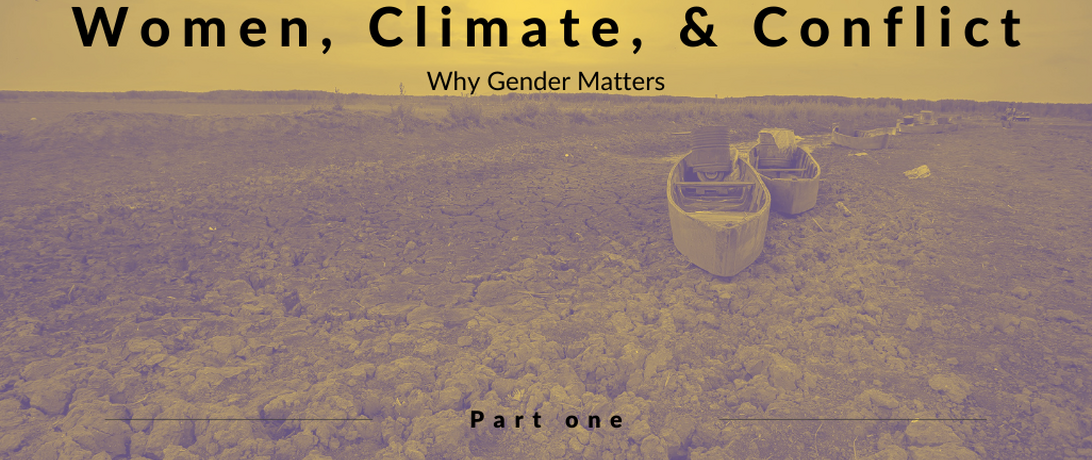
Part one of our guest blog series exploring the nexus of gender, conflict and climate change.
As a guest blog, the views expressed in this publication do not necessarily reflect the views of Our Secure Future or One Earth Future.
Climate change is a reality, one that is in the process of radically changing earth systems. In 2021 alone, we clearly see the results. Wildfires have ripped through North America towns, as well as several Canadian provinces. Floods swept away large portions of German, Dutch, and Swiss villages. Hundreds of thousands were evacuated in the Chinese city of Zhenzhou in the face of torrential rain. And small island nations are slipping below the sea. Alarmingly, the impacts of a warming world have come on faster – 10 years sooner – and more fiercely than most climate scientists thought likely. The Intergovernmental Panel on Climate Change’s (IPCC) Sixth Assessment Report, published just this month, put it plainly: “With further global warming, every region is projected to increasingly experience concurrent and multiple changes in climatic impact-drivers.” In announcing the publication of the report, UN Secretary-General António Guterres called it “code red for humanity.”
What does this have to do with women? In this series, we will explore four elements of the women-climate-conflict nexus, starting first with how climate change impacts the daily lives of women, and how climate intensifies political instability and potential conflict. If the story stopped there, it would be nothing but bad news, but thankfully the last two pieces of the puzzle are positive. Not only can indigenous women’s knowledge bolster a community’s climate resilience and adaptive capacity, women decisionmakers can change the trajectory of entire countries by pushing policy to address the gender-climate-conflict nexus at the roots. It’s a mixed bag, for sure, but before we dive into the deep end, let’s start with a very quick climate briefer.
A Very Brief Climate Primer
The Intergovernmental Panel on Climate Change (IPCC) has found that human activities have already caused global warming, and that, at the current rate, is likely to reach 1.5°C (34.7°F) of warming between 2030 and 2052. Warming above this level, the US Environmental Protection Agency warns, means the planet has hit a tipping point at which the world may become unrecognizable. Land and ocean temperatures will drop in some areas (generating more severe cold days) and spike in others (increasing heatwave intensity and frequency). Precipitation levels will change dramatically, increasing in some regions, causing floods and landslides, and decreasing in others, leading to drought. Ocean acidification will imperil marine animals, increase seal level rise and coastal flooding, and warm ocean temperatures which will contribute to more frequent and more intense hurricanes. It’s not hard to imagine that these types of dramatic changes to the earth’s ecosystems will have an impact on humans.
Disproportionate Impacts of Climate Change on Women
Climate change impacts all genders, but not to the same extent. The intersection of gendered power structures, societal expectations, and socioeconomic systems combine to make women more vulnerable to climate change. A UN Women study found that women were 14 times more likely than men to perish in a natural disaster because of a variety of gender norms that restrict the clothes they wear, whether they can leave their homes, and who can assist them. Climate change also threatens to widen gender-based health disparities. Here are a few examples:
-
Women tend to be more sensitive to heat and experience higher morbidity and mortality rates during heat waves.
-
In pregnancy, unusually hot temperatures can increase rates of hypertension and preeclampsia, change birth weight and length of gestation, increase stillbirths, and increase.
-
As with the impact of the COVID-19 pandemic, rates of sexual and gender-based violence (SGBV) are known to increase during times of disaster.
-
Climate change has already changed agricultural outputs and is expected to cause changes in the nutritional density of many foods. Due to cultural practices that prioritize the nutritional health of men and children, women may face greater nutrient scarcity during climate crises.
-
Extreme heat will lead to droughts, forcing people to seek water sources that are often toxic and usually at greater distances. Since women are primarily responsible for the collection of water, as they travel longer distances to procure it, they will be exposed to more extreme heat.
Beyond the impacts of climate change on women’s health, women’s economic wellbeing also suffers during environmental crises. The fact that women are typically responsible for two to 10 times more unpaid care work than men (e.g. family healthcare, procuring and preparing food, childcare, and collecting fuel and water) means that existing gender-based income disparities leave women earning less. Women’s unpaid care work burden is expected to increase as natural resources such as water and fuel become scarce, mass migrations become more common, and disaster-related diseases, like dengue fever, and pandemics become more frequent.
Extreme weather events will push women to work more (usually within the informal economy) to meet household needs. This will leave less time for training or education that could improve their economic situations. Additionally, reliable access to reproductive services frequently reduces the number of children women have, which enhances their abilities to improve their economic situations. But, during disasters, these services are often disrupted or nonexistent. That could mean more babies and poorer outcomes for women and their children.
This is the tip of the iceberg of how climate change will shift women’s quality of life worldwide. The situation will be even more challenging for women in low- to middle-income countries. On its own, climate change will cause many additional challenges for women but, as we shall see in the next installment of this series, when women live at the nexus of climate change and conflict, their situations become even more precarious.
Article Details
Published
Written by
Topic
Program
Content Type
Opinion & Insights